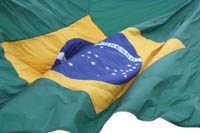Brazil is a geographically vast and varied country and driving here can be an intimidating experience for newcomers. But more than the sheer size and wavering landscape of the region, it is the roads and the driving style of Brazilian drivers that pose a greater challenge. Foreigners may have to get used to a lot of impulsive and unpredictable driving on the streets of Brazil.
For expats ready to hit the streets in Brazil, here are some helpful driving tips.
Traffic rules
Before you start driving, there are some traffic rules and regulations with which you should be familiar.• Foreigners are permitted to drive in the country for up to 180 days using their home country’s driving license, as long as it is still valid. Following this, you need to submit an application to obtain a new license.
• Drivers in Brazil drive on the right and overtake on the left hand side.
• The permitted blood alcohol content limit is 0.02mg/100ml. This means that even a single drink can put you over the limit. Therefore avoid drinking and driving, as there may be a fine to pay.
• Drivers are not allowed use to mobile phones apart from a hands-free system.
• Seatbelts are mandatory for the driver and all passengers in a vehicle.
• A child seat is necessary in case you are travelling with a small child.
• You can’t make a right turn at a red light unless there is a ‘livre a direita’ sign.
• Driving in flip-flops is illegal as is resting your elbow on the windowsill and leaning out from the vehicle.
• Drivers entering a roundabout must give way to the vehicles that are already on the roundabout.
• It is illegal to run out of petrol, even if the immobilized vehicle does not block other traffic. There are easily accessible gas stations in the country and in the cities most of them accept credit or debit cards. However in rural areas, gas stations may insist on cash only.
• Parking is only permitted in the direction of the traffic flow.
• Flashing headlights at oncoming traffic indicates that there many be some hazard ahead, such as an accident or police presence.
• It is legally mandatory to carry with you in your vehicle at all times your driving license, license papers and road tax documents. Brazilian law also makes it compulsory to keep a first-aid kit and fire extinguisher in the vehicle.
Speed limits
The speed limit is 120 km/h on main roads and highways and 60 km/h on urban roads. The limits may be further reduced around hospitals and schools, and on steep or winding roads.
Safety
• There is a high incidence of theft and car jacking especially at traffic lights and therefore not stopping at red lights at night is tolerated in cities such as Rio de Janeiro and São Paulo.
• It is advisable to keep your car windows and doors locked at junctions and also at night.
• Exercise caution when driving in the outskirts of cities or rural areas as the roads may be in poor condition. Dirt roads are commonly found in the rural interior parts of the country and are mostly used by two-wheelers and cars. The official state roads tend to be in better condition, but there are also some unofficial ones, which deteriorate after the monsoon season. If you find yourself on a dirt road and there aren’t any tracks from other vehicles, it is advisable to look for another route since the road may not be leading anywhere.
• While driving at night, look out for stray animals wandering the streets, as this is quite common in Brazil.
• Remember to always drive with caution on Brazil’s streets since many drivers flout road rules. Many times, there are vehicles driving at night with their headlights off.
• You are likely to encounter speed bumps or lombadas around schools or residential areas. They are supposed to be painted bright yellow with black stripes for easy visibility, but not all of them are. Some of these speed bumps can be rather steep and may cause damage if your car hits one of them.
• If you need to drive in São Paulo, keep in mind that the city is especially known for high road congestion and frequent traffic

